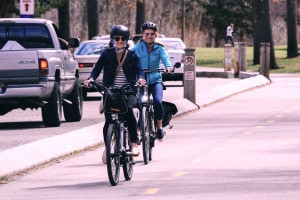This free online course introduces you to the need for non-motorized transportation (NMT) systems in urban areas and looks at the various sustainable forms of transportation – especially walking and cycling - and their impact on the environment. Next, the process of planning the different scales of NMT infrastructure and the estimation of the demand for NMT systems through various primary and secondary data sources will be explained. You will study the integration of NMT strategies with other transport plans and the process of developing incentives for private stakeholders to invest in NMT infrastructure, as well as establishing budget allocations for NMT rehabilitation and maintenance. This includes various methods for selecting the best interventions based on cost and economic analyses. Next, the different characteristics for each type of NMT with respect to its variation in size and dimension, and the hindrance of pedestrian speed based on individual characteristics and built environment, are also explained. You will be taken through the various models that are used to establish pedestrian flow and the significance of linear regression analysis in establishing statistical relationships, including the process of determining the goodness of fit of the actual data.
The course goes on to explain the different types of crossing facilities and the factors to be considered when designing pedestrian facilities. Learn about flow parameters and the process of estimating critical pedestrian gaps using Raff’s method. The process of estimating the pedestrian level of service (PLOS) for sidewalks and crosswalks at a signalized intersection is also explained, including the estimation of PLOS based on the effectiveness of the flow rate as well as the users’ response. You will get familiar with the method of developing a PLOS for the various linked intersections along urban streets, and the association of the crossing difficulty with delay in crossing the road, as well as the midblock, is also explained. This will include the association of the facility PLOS with the length of the weighted PLOS segment score and the average space per pedestrian. Various guiding and supporting principles involved in designing the facilities for NMT systems in urban areas are then described.
Finally, the design guidelines for pedestrian facilities as per the Indian Road Congress (IRC) and the process of designing such facilities in urban areas to ensure seamless access for pedestrians will be analyzed. This includes the process of deciding the width and capacity of the sidewalks and the principles associated with the design of crosswalks, mid-blocks and kerb-ramps in urban areas. Then, the process of designing different cycling infrastructure for the various hierarchy of routes in urban areas, and the significance of intersection sight distance in ascertaining the safety of cyclists, are highlighted. Lastly, the role of parking in retaining cycling as an attractive mode of transport and the factors to be considered while designing the crossings for the specially-abled persons are explained. On completion of this course, you will be able to understand the complex planning and design characteristics of non-motorized transportation systems in urban areas. Those involved in civil engineering, transportation engineering and urban planning will find this free online diploma to be a useful extension of their knowledge. Sign up for this course now and you can start studying today.
What You Will Learn In This Free Course
View All Learning Outcomes View Less All Alison courses are free to enrol, study, and complete. To successfully complete this Diploma course and become an Alison Graduate, you need to achieve 80% or higher in each course assessment.
Once you have completed this Diploma course, you have the option to acquire an official Diploma, which is a great way to share your achievement with the world.
Your Alison certificate is:
- Ideal for sharing with potential employers.
- Great for your CV, professional social media profiles, and job applications.
- An indication of your commitment to continuously learn, upskill, and achieve high results.
- An incentive for you to continue empowering yourself through lifelong learning.
Alison offers 2 types of Diploma for completed Diploma courses:
Digital Diploma: a downloadable Diploma in PDF format immediately available to you when you complete your purchase. Physical Diploma: a physical version of your officially branded and security-marked Diploma All Diplomas are available to purchase through the Alison Shop. For more information on purchasing Alison Diploma, please visit our FAQs. If you decide not to purchase your Alison Diploma, you can still demonstrate your achievement by sharing your Learner Record or Learner Achievement Verification, both of which are accessible from your Account Settings.













 Avg. Hours
Avg. Hours  CPD Accredited
CPD Accredited 
 Total XP:
Total XP: 
 Knowledge & Skills You Will Learn
Knowledge & Skills You Will Learn 





